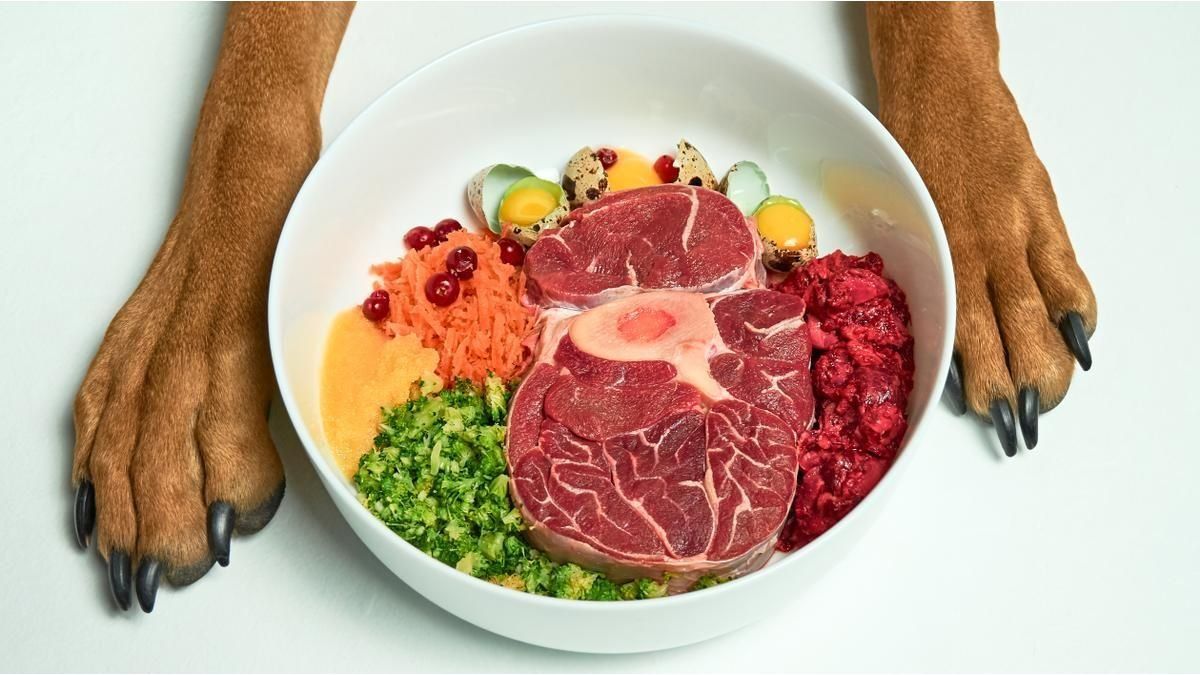In recent years, the trend of a new routine and feeding program for our dogs and cats. By its acronym in English Biologically Appropriate Raw Food (Biologically Appropriate Raw Food), the BARF feed It is based on providing raw food, with a proportion of 60 and 80% bones, meat, organ meats, eggs, milk and between 20 and 40% fruits, legumes and vegetables, to companion pets.
It is based on feeding them raw food following their original nutrition like carnivorous animals. Trying to imitate, as much as possible, what they would eat if they lived in nature. This trend promises benefits for your health, suggesting improvements in digestion thanks to an altered gut microbiome.
However, it is a nutritional plan that generates a lot debate. Its defenders highlight the good health of the teeth, the shine of the hair, the improvement of chronic diseases such as osteoarthritis and growth problems, the strengthening of tendons and ligaments, and protected immune systems as it does not contain any type of added ingredients. or preservative.
It is estimated that raw pet food sales have increased at least 15% annually in recent years and that approximately 10% of cats and 15-25% of dogs They are currently fed raw meat. Although most veterinary and public health organizations These diets are discouragedare still popular.
Different scientific studies have warned that it would not be as good as it is proposed. Their research is still in its early stages, and the true benefits are not supported by a solid scientific basis. The concern is not only focused on its nutritional effectiveness, but also on the health risks of pets and humans.
image-84jpg.webp
BARF Diet Debate: Its Benefits
The BARF diet is increasingly popular around the world. It is estimated that approximately 10% of cats and 15-25% of dogs are currently fed raw meat. Their defenders, those guardians who were inclined towards a natural diet, quickly noticed multiple positive changes on the health of your pets. These benefits include:
- Digestion and absorption: When presented raw or semi-cooked, foods will have enzymes, vitamins and minerals, which will favor the absorption of nutrients and their use.
- Dental health: by chewing and biting fibers and bones, you would be eliminating the plaque and tartar of the teeth, and problems such as cavities or other diseases that can lead to the animal losing teeth will be avoided.
- Skin, hair and bones: The BARF diet has high amounts of minerals such as zinc or calcium, vitamins such as biotin and essential fatty acids, which makes pets healthy. Also improving the quality of the hair.
- It will help prevent diseases and in the reduction of allergies. Many animals with food intolerance find relief with this program.
- Energy and vitality: pets stay longer active, vital and sleep less.
- Improvement in stool: less odor and more compact.
image-255.png.webp

Why do some experts not recommend it?
Science is still studying the effects of this diet on pets and various investigations have warned about the impact it can have on both dogs and cats, in addition to humans.
Initially, the National Collaborating Center for Environmental Health in Vancouver warned that this diet could cause antibiotic resistance. Some raw meats are not subject to microbiological inspections or tests specific, which leaves the door open to a high risk of bacterial contamination and different pathogens that affect public health and our pets.
Studies show that pets fed raw meat exhibit higher rates of pathogenic bacteria, such as Salmonella and E. colinot only in the food itself but also in its feces. This makes it a potential means of transmission of antimicrobial-resistant bacteria between pets and humans.
In this sense, research by the Center for Veterinary Medicine (CVM) in the United States, carried out between 2010 and 2012, investigated more than 1,000 pet foods in search of dangerous pathogens. The results showed that raw foods are more susceptible to being contaminated with bacteria, compared to others: of 196 raw food samples, 15 were positive for Salmonella and 32 for Listeria monocytogenes.
Another important aspect to take into account is the existence of nutritional risks specifics linked to these diets. Since poor planning can lead to malnutrition lack of essential foods or overweight or obese due to excess of others. Such as excessive fat and/or protein content, calcium and phosphorus imbalances, and deficiencies in specific minerals and vitamins, such as potassium, zinc, magnesium, and vitamin D.
Some specialists do not recommend it for these other reasons:
- Fractures or obstructions: Containing raw or semi-cooked bones, pets may suffer from tooth fractures or intestinal blockages, which may lead to emergency surgery.
- Butcher shops: it is important to buy the meats in trusted places so that they are free not only of bacteria or parasites, but to guarantee that they are free of antibiotics, anti-inflammatories or other medications.
- Allergies and poisonings: The BARF diet includes foods such as eggs or nuts, which can cause allergies in pets or risks of poisoning.
It is necessary to emphasize the importance of inform yourself and consult with your primary veterinarian. Each pet is unique, so a periodic evaluation is essential to corroborate the nutritional needs that vary depending on age, breed, physical condition and health.
Finally, the American Veterinary Medical Association highlighted the key influence of pasteurization or cooking of food. He warned that it must be carried out until a safe minimum internal temperature is reached, in addition to other scientifically validated technologies to reduce the presence of pathogens.
Source: Ambito
I am an author and journalist who has worked in the entertainment industry for over a decade. I currently work as a news editor at a major news website, and my focus is on covering the latest trends in entertainment. I also write occasional pieces for other outlets, and have authored two books about the entertainment industry.




